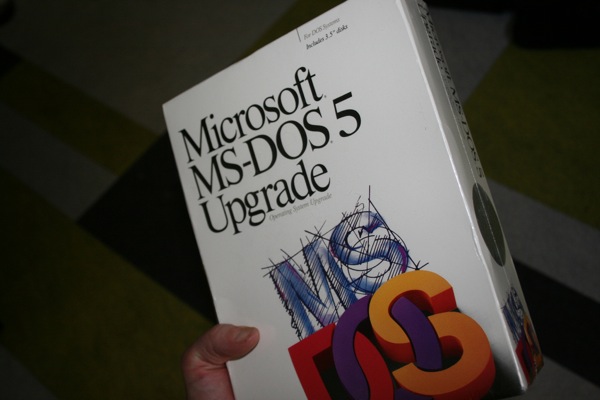The week of July 27th, 2011 marked the 30th anniversary of the invention of the operating system that was the standard for PCs for the first 15 years or so of the platform’s life, MS-DOS.

image source: mrdorkesq
While modern PCs run spiffy graphical versions of Windows (or Linux), for many years, users were greeted by a simple, textual prompt, either “A:\>” or if you were lucky enough to have a hard drive, “C:\>”.
In 1980, IBM was as synonymous with computers as Kleenex was to tissues. But Big Blue sensed a threat to their empire from some hippies in California. The Apple II was making inroads into homes, schools, and, much to IBM’s dismay, business. They needed to get a personal computer out quickly if they weren’t going to be buried by Apple, Commodore and Atari.
To get their machine out as soon as possible, IBM opted to use off-the-shelf components instead of designing everything in-house, as usual. This included the software.
The king of personal computer operating systems was CP/M, developed by Gary Kildall’s Digital Research. Licensing CP/M seemed like a natural decision, but IBM representatives found themselves rebuffed when they went to meet Kildall down in Montery, Calif. Legend has it that Kildall blew off the meeting in order to enjoy the near-perfect flying weather in his private plane, but apparently that story is false. It’s more likely that Kildall thought the machine would never catch on, because who would buy a personal computer built by a mainframe company?
In desperation, IBM turned to Microsoft, who promised them an operating system. But in 1980, Microsoft was known as a programming language company, not an operating system company. They went out and bought one from Seattle Computer Products, called “QDOS” by its inventor, Tim Paterson, for “Quick and Dirty Operating System.” It was a very faithful clone of CP/M or, as some might say, a complete rip-off.
Microsoft renamed it PC-DOS for IBM computers and MS-DOS for other Intel-based computers. Microsoft made sure they retained the rights to their operating system, a decision that would lead the the rise of Microsoft and the eventual loss of IBM’s dominance of the PC market.
MS-DOS was finally superseded by Windows with the release of Windows 95, but for geeks old enough to remember it, it offers some fond memories (mainly old games) and not-so-fond memories (managing memory and tweaking AUTOEXEC.BAT to get those games to work).
If this post has you feeling nostalgic for the DOS days, check out a way to play classic DOS games on Chrome. A modern open source version, FreeDOS, is covered in 5 Little-Known Open Source Operating Systems.










